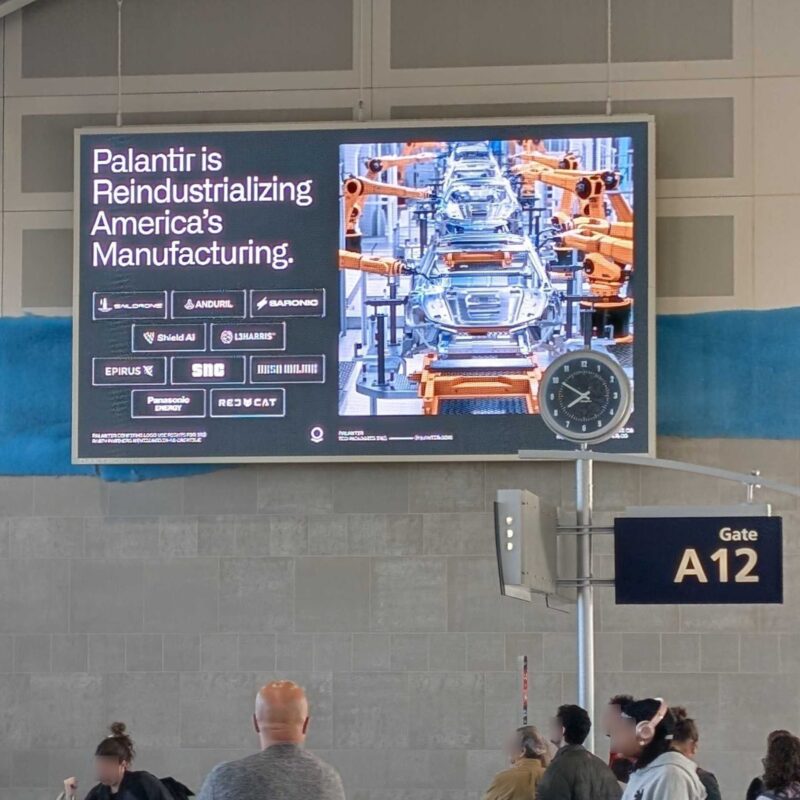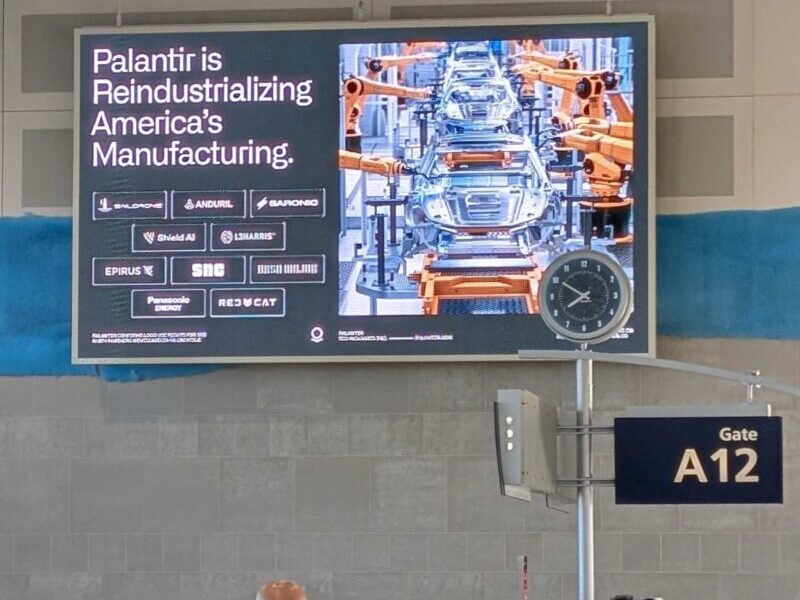Industrial Policy vs. Digital Reality: How Data, Not Labor, Is Rebuilding the Rust Belt
 This Palantir advertisement, displayed at the Detroit airport—a symbolic and literal hub of U.S. industrial manufacturing—makes a highly strategic and ideologically charged claim: “Palantir is Reindustrializing America’s Manufacturing.” The ad visually juxtaposes sleek, robotic car manufacturing lines with logos of firms heavily invested in AI, defense tech, and automation (e.g., Anduril, Shield AI, L3 Harris, Red Cat, Epirus).
This Palantir advertisement, displayed at the Detroit airport—a symbolic and literal hub of U.S. industrial manufacturing—makes a highly strategic and ideologically charged claim: “Palantir is Reindustrializing America’s Manufacturing.” The ad visually juxtaposes sleek, robotic car manufacturing lines with logos of firms heavily invested in AI, defense tech, and automation (e.g., Anduril, Shield AI, L3 Harris, Red Cat, Epirus).
The underlying argument is clear: the “rebirth” of American manufacturing is not about reopening shuttered factories or restoring lost industrial jobs; it’s about digitizing and automating production through AI-driven operational intelligence, real-time data integration, and military-industrial R&D ecosystems. Palantir’s information-centric narrative positions software, hardware, and data as the new industrial substrate. The image of robotic arms and unstaffed assembly lines reinforces the vision of a post-labor manufacturing sector where operational optimization, predictive analytics, and AI-enabled decision-making—services Palantir provides—are the key inputs, not labor or even physical capital in the traditional sense.
The firms listed (e.g., Anduril, Shield AI) are not traditional manufacturers but data-intensive defense-tech and aerospace-adjacent startups. These partnerships suggest that Palantir sees reindustrialization as an extension of the national security state into the economic realm, where industrial capacity is measured in real-time intelligence and autonomous systems, not steel production or employment rates.
Contrast with Trump and Biden Industrial Policy
To understand how far Palantir’s model deviates from conventional political visions of manufacturing revival, consider the contrast with recent U.S. industrial policy. It is sharply at odds with the Trump administration’s populist-oriented vision of reindustrialization, which has focused on:
- Protectionist trade policy: tariffs on steel, aluminum, and Chinese goods to protect domestic industries.
- Onshoring jobs: incentives for firms to bring manufacturing jobs back to the U.S., particularly to Rust Belt states.
- Reviving legacy sectors: support for coal, oil, and traditional automotive manufacturing.
Palantir’s model, by contrast, implies that the return of manufacturing is not a jobs program. Instead, it’s a national project of strategic autonomy, efficiency, and techno-sovereignty, enabled by predictive platforms and dual-use innovation. There is no nostalgia here for “middle-class” factory work; instead, it’s a vision of data pipelines, algorithmic supply chains, and defense-integrated production.
This vision aligns more with the Biden administration’s CHIPS and Science Act and IRA, which channeled industrial policy toward semiconductors, green energy, and AI, invoking economic nationalism and national security to justify investments that seemingly bring jobs back to the Rust Belt.[1] But even those efforts, which contain labor and equity provisions, contrast with Palantir’s more austere, techno-nationalist vision of growth through automation and digital infrastructure.
What Industrial Policy Gets Wrong
Neither administration’s industrial policy aligns with what’s occurring. The Bureau of Economic Analysis reports that between 1997 and 2024, information services have grown at over twice the rate of durable goods manufacturing as a share of GDP. Yet policy still privileges atoms over bits. What both administrations fail to fully embrace is that the true engine of U.S. (and other nation-states) economic dynamism is not reshored jobs or supply chains—it is the relentless integration of digital networks, data flows, and algorithmic coordination across global markets.
Palantir’s ad makes the transformation explicit: from muscle to microchips, from labor to logic. Firms respond to subsidies and mandates, but they do so by investing in automation, software, and operational intelligence—not by recreating mid-century industrial employment. Industrial policy may tweak inputs and distort markets, but the structure of a globalized, information-driven economy dictates outcomes.
What’s more, both the Trump and Biden administrations tie industrial policy to national security objectives. From subsidies to export controls and tariffs, economic intervention is justified not by competitiveness or welfare, but by geopolitical rivalry—especially with China. This securitization hollows out stakeholder debate over economic priorities and subordinates civil society and business interests to militarized logics. Reindustrialization is not inherently bad. But when it’s captured by the security state and divorced from stakeholder accountability, it becomes less a path to shared prosperity and more a means of entrenching “techno-sovereignty” in service of perpetual conflict.
If we are serious about continuing to foster the unprecedented economic growth associated with networks and data of the past 25 years, we must also stop using industrial policy to implement a national security strategy. Reindustrialization today is not a return—it’s a reinvention. And it demands governance that starts with the economy we actually have: digitized, transnational, and organized around data flows, not factories.
[1] Among the companies featured in the advertisement, Anduril Industries plans a notable presence in the Rust Belt. Just before the start of the Trump administration, the company announced construction of “Arsenal-1,” a 5-million-square-foot advanced manufacturing facility near Columbus, Ohio. This plant is expected to create approximately 4,000 jobs and will focus on producing autonomous systems and defense technologies. The selection of Ohio was influenced by the state’s available workforce and supportive state government. There are other CHIPS-related examples, e.g., Micron’s planned megafab in Syracuse, New York. Other companies like Shield AI, L3Harris, Red Cat, and Epirus do not have a significant manufacturing presence in the Rust Belt. Their operations are primarily based in other regions, focusing on advanced technologies and defense systems.
The post Industrial Policy vs. Digital Reality: How Data, Not Labor, Is Rebuilding the Rust Belt appeared first on Internet Governance Project.

